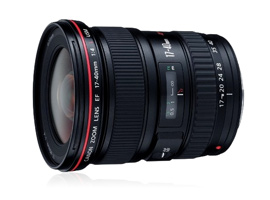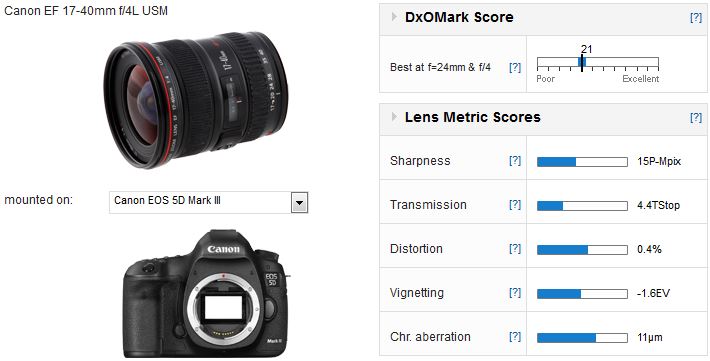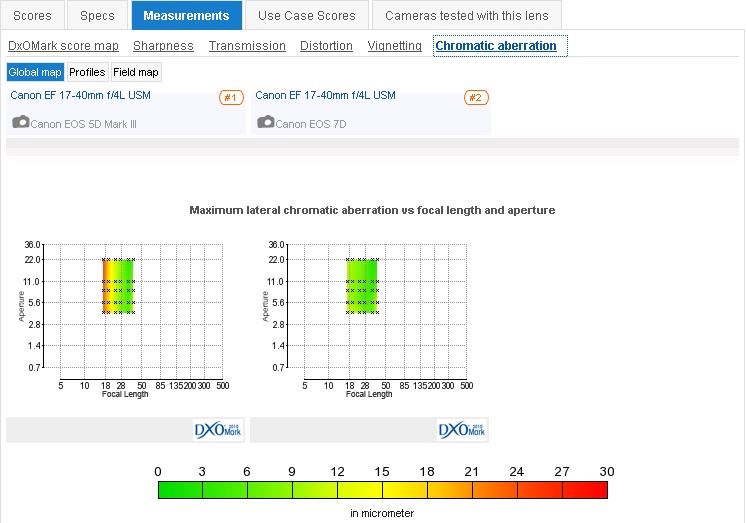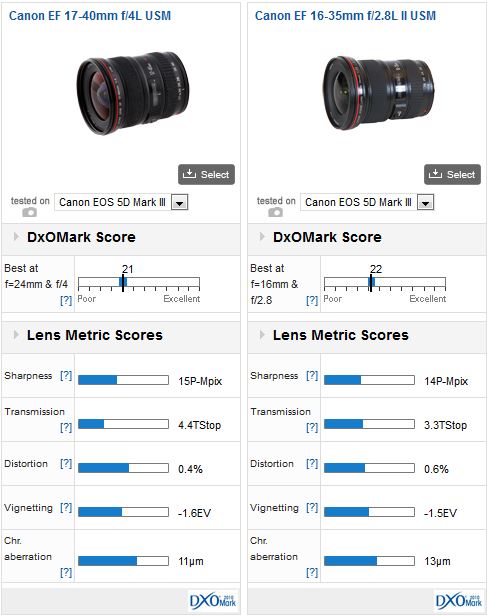Introduction
Introduced in 2003 the EF 17-40 f/4L USM was one of the first of the lightweight pro-level L-series zooms from the firm adopting a constant f4 aperture. Not only does that make the lens relatively small and more portable compared with the f2.8 varients, but it also helps keep it moderately priced. This full-frame lens is also popular with users when mounted on APS-C cameras where it’s the equivalent to a 27-64mm. Like other L-series lenses from the company, the EF 17-40mm f/4L has a high grade optical construction consisting of three aspherical lens elements and even adopts a Super-UD glass element, an expensive glass type usually resevered for more esoteric lenses in the range. The 12-element 9-group construction allows a closer than usual minimum focusing distance of 11.02” (0.28m). It weighes 1.05 lb (475g) and measures 3.81” (96.8mm) in length, and is available now for $839
 |
 |
 |
 |
| Tokina AT-X 16-28 F2.8 PRO FX Canon | 849 | 22 | 17 |
| Canon EF 16-35mm f/2.8L II USM | 1399 | 22 | 14 |
| Canon EF 17-40mm f/4L USM | 780 | 21 | 15 |
| Canon EF 16-35mm f/2.8L USM | 1674 | 20 | 14 |
| Sigma 17-35mm F2.8-4 EX DG Aspherical HSM Canon | 350 | 20 | 11 |
| Canon EF 20-35mm f/3.5-4.5 USM | 299 | 19 | 14 |
| Sigma 17-35mm F2.8-4 EX Aspherical HSM Canon | 700 | 19 | 11 |
| Sigma 12-24mm F4.5-5.6 EX DG HSM II Canon | 1400 | 15 | 12 |
| Sigma 12-24mm f4.5-5.6 EX DG Canon | 840 | 14 | 8 |
Canon EF 17-40mm f/4L USM lens performance: Very good sharpness, particularly at the wider-end
The Canon EF 17-40mm f/4L USM achieves a high ranking for an ultra-wide angle lens with DxOMark score of 21 points. Peak sharpness at 15P-Mpix is perhaps a little behind the latest designs but it’s still very good. Like so many zooms, it’s better at the wider end where it has good uniformity, even wide-open.
At 35mm and above, sharpness drops somewhat at the maximum aperture, particularly in the outer field but that improves steadily when stopped down, with peak performance at f/8-11. Chromatic aberration is well reasonably controlled, particularly from 24-40mm but it’s evident in the extreme corners at 17mm. However on an APS-C camera with its smaller sensor CA isn’t an issue, and that’s pretty much the same for vignetting.
Canon EF 17-40mm f/4L USM versus Canon EF 16-35mm f/2.8L II USM both mounted on Canon EOS 5D Mark III: Competitive performence
When compared against the $1,699 Canon EF 16-35mm f/2.8L II USM, the smaller, lighter f/4 model holds its own.
In fact the two perform at a similar level. The faster lens is a better performer at 35mm but the 17-40mm has more uniform sharpness across the field and marginally higher peak sharpness (albeit at different settings between them, and a difference of 1P-Mpix is trivial in real world terms).
The 16-35mm f/2.8L even has slightly higher levels of lateral chromatic aberration covering a larger area at its widest focal length, though levels are very low by 20mm. That’s quite an achievement although it’s worth remembering that the 16-35mm lens is both slightly wider and a stop faster (or just less when comparing Transmission).
Due to its more glamorous sibling this modest lens is often overlooked though it’s well known for its high-performance by Canon users. As a small, light, highly portable zoom it would make a great choice for travel, landscapes and general-purpose photography. Although not exactly cheap at $839, if portability is a concern it’s a great alternative to the faster model.








DXOMARK encourages its readers to share comments on the articles. To read or post comments, Disqus cookies are required. Change your Cookies Preferences and read more about our Comment Policy.